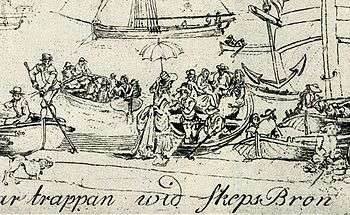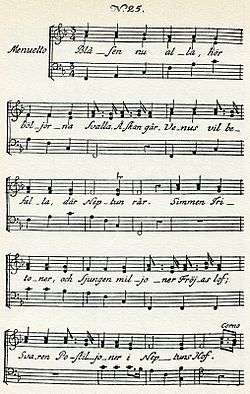Blåsen nu alla
_-_03.jpg)
Blåsen nu alla, "All blow now!" (or Bloweth now all), is one of the Swedish poet and performer Carl Michael Bellman's best-known and best-loved songs, from his 1790 collection, Fredman's Epistles, where it is No. 25. It is a pastorale, based on François Boucher's rococo 1740 painting Triumph of Venus.
The epistle is subtitled "Som är ett försök till en pastoral i bacchanalisk smak, skriven vid Ulla Winblads överfart till Djurgården" (Which is an attempt at a pastorale in Bacchanalian taste, written on Ulla Winblad's crossing to Djurgården)
Context

Carl Michael Bellman is the central figure in Swedish song, known for his 1790 Fredman's Songs and his 1791 Fredman's Epistles. He played the cittern, accompanying himself as he performed his songs at the royal court.[2]
Jean Fredman is a fictional character and the supposed narrator in Bellman's epistles and songs, based on a real watchmaker of Bellman's Stockholm.[3] The epistles paint a picture of the demimonde life of the city during the eighteenth century, where strong drink and beautiful "nymphs" like Ulla Winblad create a rococo picture of life (as in this Epistle, and in No. 28, I går såg jag ditt barn, min Fröja), blending classical allusion and pastoral description with harsh reality.[2][3]
Song

 |
Melody of Epistle 25
|
| Problems playing this file? See media help. | |
Blåsen nu alla is a song in eight verses, each of 15 short lines. The rhyming pattern is AABAB-CCDCD-EEEFF.[4] It is in 3/4 time and is marked Menuetto (Minuet).[5] The melody has the timbre "Waldthorns-stycke" but is origin beyond that is unknown.[6]
The song, which Bellman called "his Epistle", begins with a rococo theme, with the classical goddess Venus crossing the water, as in François Boucher's Triumph of Venus, but when she disembarks, Bellman transforms her into a lustful Ulla Winblad. In his time, the painting hung in Drottningholm Palace.[1][7]
The Epistle was planned as the grand finale to Bellman's planned initial collection of 25 Epistles, the grandiose assembly of figures from classical mythology contrasting with the reality of a boat crossing.[8]
Reception
The song has been recorded by Sven-Bertil Taube[9] and Mikael Samuelsson (Sjunger Fredmans Epistlar, Polydor, 1990)[10] among others.
References
- 1 2 Britten Austin, 1967. page 108, and facing page 88
- 1 2 "Carl Michael Bellmans liv och verk. En minibiografi (The Life and Works of Carl Michael Bellman. A Short Biography)" (in Swedish). The Bellman Society. Retrieved 25 April 2015.
- 1 2 Britten Austin, 1967. Chapter 3: Fredman's Epistles, pp 61-93.
- ↑ Kleveland, 1984, pages 22–26
- ↑ Kleveland, 1984, pages 106–107
- ↑ Massengale, page 168
- ↑ Hägg, 1996. pages 156-157.
- ↑ "Om Fredmans epistlar och sånger" (in Swedish). Bellman.org. Retrieved 12 March 2016.
- ↑ "Alla Fredmans epistlar tolkade av våra förnämsta artister / Carl Michael Bellman". Svensk Mediedatabas. Retrieved 12 March 2016.
- ↑ "Mikael Samuelson – Sjunger Fredmans Epistlar". Discogs. Retrieved 12 March 2016.
Sources
- Bellman, Carl Michael (1790). Fredmans epistlar. Stockholm: By Royal Privilege.
- Britten Austin, Paul. The Life and Songs of Carl Michael Bellman: Genius of the Swedish Rococo. Allhem, Malmö American-Scandinavian Foundation, New York, 1967. ISBN 978-3-932759-00-0
- Britten Austin, Paul. Fredman's Epistles and Songs. Stockholm: Proprius, 1990 and 1999.
- Hassler, Göran; Peter Dahl (illus.) (1989). Bellman – en antologi [Bellman – an anthology]. En bok för alla. ISBN 91-7448-742-6. (contains the most popular Epistles and Songs, in Swedish, with sheet music)
- Hassler, Göran; Peter Dahl (illus.) (1989). Bellman II – en antologi [Bellman – an anthology]. En bok för alla. ISBN 91-7448-837-6. (contains the remaining Epistles and Songs, in Swedish, with sheet music)
- Kleveland, Åse; Svenolov Ehrén (illus.) (1984). Fredmans epistlar & sånger [The songs and epistles of Fredman]. Stockholm: Informationsförlaget. ISBN 91-7736-059-1. (with facsimiles of sheet music from first editions in 1790, 1791)
- Massengale, James Rhea (1979). The Musical-Poetic Method of Carl Michael Bellman. Stockholm: Almqvist & Wiksell International. ISBN 91-554-0849-4.
